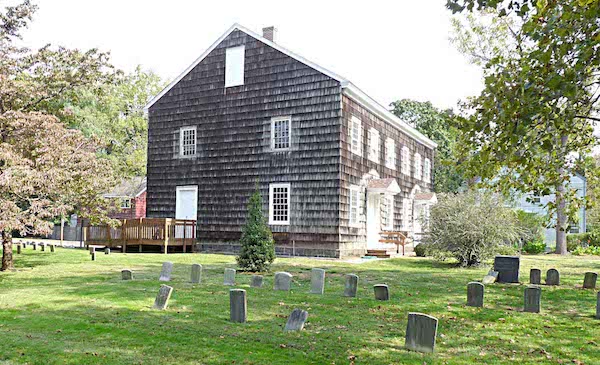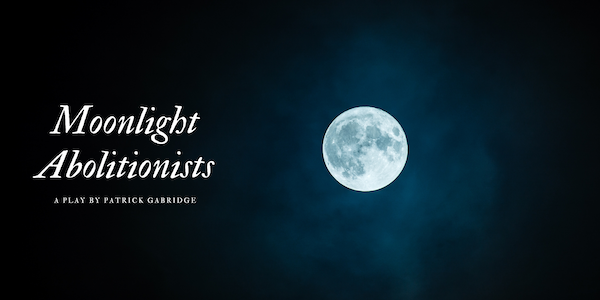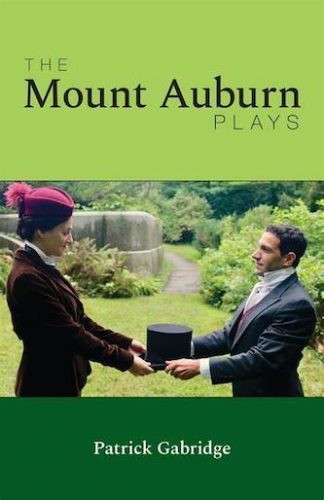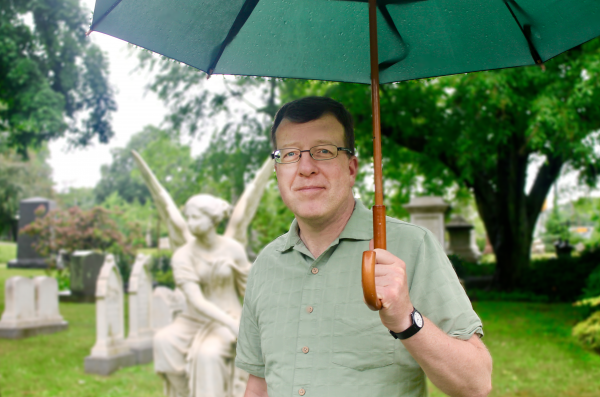Theater Interview: “Moonlight Abolitionists” — Graveyard Shift
By Bill Marx
“In these plays, part of my job is to unflatten history in a way that’s engaging, and also shows us that it’s okay for us to feel overwhelmed and confused and scared by the world — that we’re not so different from the people who came before us. They got through it, and we will, too.”

The Shrewsbury Quaker Cemetery — during the daytime. It is scarier at night, take it from me.
The last time I attended a performance in a graveyard I was around 11 years old. It was a hallowed (male) suburban New Jersey tradition, accepting a double dare made by friends to sleep overnight in a boneyard. So, late on a summer evening in the early ’60s, I grabbed my sleeping bag and a flashlight and deftly sneaked out of the house. I walked, as undetected as possible, over to the Shrewsbury Quaker Cemetery on the corner of Broad Street and Sycamore Avenue. All was comfortable enough at first, if a tad spooky, until my pals showed up. They hid behind trees and rolled about on the grounds, making all kinds of weird noises and shuffling sounds. Let’s say that — at that point — my critical faculties were insufficiently developed. I fell for the act. Scared of what was going bump in the night, I grabbed my sleeping bag and ran home. I didn’t hear the end of it for a long time.
That Proustian memory bumped to mind when I learned about the unusual staging of Patrick Gabridge’s Moonlight Abolitionists. It is going to be performed, at night and under a full moon, in Cambridge’s venerable Mount Auburn Cemetery (on September 20, 21, and 22) via a Plays in Place concert reading directed by Megan Sandberg-Zakian. Of course, there is strength in numbers when it comes to hanging out in graveyards after the sun goes down (as of now all three evenings are sold out), but I was curious about what motivated this mildly scary set-up. Why present a show dedicated to abolitionists buried in Mount Auburn on site, so to speak? And lit by moonlight? Is this a protest against our love of the virtual and fear of death?
I had also been moved by the 2019 production of Gabridge’s The America Plays, a quintet of historical dramas staged (during the daytime) in Mount Auburn Cemetery. So I sent the playwright, via e-mail, a few questions about Moonlight Abolitionists. I also couldn’t help but ask the local dramatist where he thought theater was going as we emerge from the pandemic.

Arts Fuse: In the preface to the Moonlight Abolitionists, you write that “Night at the Cemetery is a time of deep concentration — it is not a frightening place at all.” What is the appeal of staging a play where audience members might feel uneasy?
Patrick Gabridge: Mount Auburn Cemetery was founded in 1831 on the very idea of changing the relationship between the living and the dead — doing away with the harsh, overcrowded, unsanitary burial grounds that had a Cavlinistic bent — “you’d better get your act together, because you’ll be here soon” sort of vibe. Inspired by Pere La Chaise cemetery in Paris, Mount Auburn was instead about providing ground for quiet contemplation, mourning, and a chance to consider our place in the world, surrounded by beautiful grounds and monuments. This goes hand in hand with the rise of New England’s Transcendentalists.
Which is a long way of saying that Mount Auburn Cemetery is the opposite of a scary place. Though I will admit, the first time I was there at night, I almost reflexively felt a little uneasy. Until I took a breath and listened and took in the peacefulness of the place.
I wrote this play to take place at Mount Auburn under the full moon, because I wanted to give people a chance to experience this special place in a really unique way. Maybe some audience members would have some trepidation, but I was confident that those willing to give it a try would find it a rewarding experience.
As a writer of site-specific plays, I also was in love with the idea of crafting a theatrical experience designed to be done under the full moon, in the near darkness, in a very intimate environment. I’d already written 10 one-acts to be performed at Mount Auburn, as part of my residency (The Nature Plays and The America Plays), and this was a bonus play. My original plan was actually to write a play that could only be performed in the rain, but the logistics (I’m also the producer, so I have to worry about such things) were too much to manage. The full moon felt much more do-able, though we still have to schedule very carefully (there are only about 9 nights a year when the moon and light are just right) and have to worry about the weather.
It’ll be worth it.
AF: A play about the abolitionists buried in Mount Auburn is understandable — what led you to pick these particular six figures?
Gabridge: I’d come across Charles Turner Torrey in my early research during my residency and was fascinated by his story. And Harriet Jacobs seemed impossible not to write about, though she’s much more known than Torrey. As I did more research, The Secret Six, who helped fund John Brown, stood out as fascinating figures, and I was glad that two of them were buried at Mount Auburn (George Stearns and Samuel Gridley Howe). Mary Stearns, George’s wife, was an important partner in his abolition work, and she had a fascination with John Brown. Joshua Bowen Smith is very little known Black abolitionist, but was active in the movement and represented a turning away from Garrisonian pacifism to a more active resistance (which is true of all six of these figures, really). When writing the piece, I was trying to understand how these figures were all connected, and unearthing that spiderweb was fascinating. There are small threads tying them together, some directly, some indirectly. All of them were willing to make incredible sacrifices to end slavery, in ways that I think offer a challenge to anyone encountering them.
AF: Were you tempted, for the sake of dramatic confrontation, to include figures buried at Mount Auburn who were in favor of slavery?
Gabridge: Not really. In one of The Nature Plays, in Namesakes, I’d explored that sort of racial legacy in the character of Louis Agassiz, and touched on Jacob Bigelow’s initial ambivalence towards slavery (and then his move away from it) in The America Plays. In this play, I didn’t need pro-slavery characters there in order for the abolitionists to have their say. And I don’t imagine that the ghosts of the abolitionists would be too excited to spend their nights with slavers.
 AF: Despite having contributed to the end of slavery, some of these people are still filled with anger, such as the Black caterer Joshua Bowen Smith. This is not Our Town’s vision of spirits drifting into indifference to earthly matters. Why have you taken another approach?
AF: Despite having contributed to the end of slavery, some of these people are still filled with anger, such as the Black caterer Joshua Bowen Smith. This is not Our Town’s vision of spirits drifting into indifference to earthly matters. Why have you taken another approach?
Gabridge: In Smith’s case, my research indicated that the damage done to his business and life (by Governor Andrew) played a big part in killing him. His is a story of a successful Black businessman getting screwed by powerful white men that feels awfully current. I think it’s too much to ask Harriet Jabobs to forgive her enslavers and tormentors, and I’m certainly not going to create it dramatically when it doesn’t seem to appear in her own writings. Maybe part of what drew me to these six characters was how intensely they fought for abolition, for equal rights, and that I couldn’t imagine that fighting impulse, which sometimes can be accompanied with anger and bitterness, would dissipate quite so easily, even after death and time. (I just want to add that I love Our Town, and our director, Megan Sandberg-Zakian, was involved with a staging of it at Mount Auburn with Underground Railway Theatre some years ago.)
AF: One of the characters mentions being “mis-remembered” — how concerned were you about correcting the record?
Gabridge: I do a lot of historical work, and the more research I do, the more I realize how hard it is to be sure I’m getting the actual story, and how easily it is to be misled. When it comes to white abolitionists, I’m very interested in the dichotomy that existed in many of them between an abhorrence of slavery and an inherent sense of white superiority/supremacy they also held. I’d gone into this piece thinking that Howe would be a strong example of that, but it turns out that his racist views weren’t nearly as strong as I thought (as compared to his wife). Howe is deeply flawed, for sure, but I felt I owed it to him not to paint him unfairly in that regard.
AF: Do you see theater as a way to explore the past? In a culture whose attention span is increasingly short.
Gabridge: A lot of my writing is on historical subjects, so I’d say Yes, of course. But I also think that the most effective theatrical explorations of history are focused by the lens of the present. I’m looking at historical stories and characters to explore what it means to be human. I think in order for us to fully understand the present, it helps to understand how we got here. And to understand that the people in our past were not so different from us — they had loves and desires and betrayals and losses. And they didn’t always know what to do or how to respond to a world that is full of injustice and horrors, as well as beauty and joy. In these plays, part of my job is to unflatten history in a way that’s engaging, and also shows us that it’s okay for us to feel overwhelmed and confused and scared by the world — that we’re not so different from the people who came before us. They got through it, and we will, too.
As for attention span, people are interested in compelling characters and stories. I don’t know if they care whether those are historical or not, they want to be captivated. I find no shortage of exciting stories and people from history, and audiences seem interested to come along for the ride.
AF: A key word for me in this play is sacrifice — these are people who were willing to give up just about anything — their possessions, comfort, and freedom — for the sake of ending slavery. In a time of political extremity — at least from the right — what is the value of the play’s message?
Gabridge: I hope the characters in this play can serve as an inspiration for people who do feel passionately about growing injustices in our world to be willing to step up and take action. The size of the obstacle dictates the measure of the necessary response. There were plenty of people back in the 1830s and 1840s signing petitions to end slavery, thousands of them in Massachusetts alone. But it took a lot more than that to end slavery (Mary Stearns talks a lot about action). Resolving some of our current political injustices and outrages are going to take more than signing online petitions and posting on social media. We are all challenged to sacrifice for what we believe is right. Most of us won’t do much. Maybe these six characters will at least allow us to ask ourselves what we will be willing to do.
AF: What are your feelings about the direction that local theater is taking as we (seem to be) moving away from the pandemic? In contrast to this play, the emphasis seems to be on reassurance, on entertainment and comedy.
Gabridge: There are a lot of conflicting forces at play in the theater world right now. Due to the pandemic, companies have been without income for a year and a half. There was some governmental support, but not nearly enough for a field that employs and reaches so many people. Here in Boston, we lost New Rep, but so many other companies are struggling. Theaters are under a lot of pressure to stage shows in which they feel confident that people will buy tickets and also have low costs (smaller casts). So many artists have had to find other work in the past year and a half, so there’s a ton of pressure to find and hire personnel. And the murder of George Floyd and its repercussions afterwards for society have been shaking things up, and putting positive pressure on theaters to stage plays that are giving voice to people whose voices have not been heard on our stages.
We’ll see how things go. We’re in the midst of a pandemic (that hopefully will wane again) — I think it’s not unreasonable for companies to think that audiences are going to need a laugh and a bit of relief. Especially to start their seasons and to get people back into the habit of going to live theater.
The seasons I’m seeing programmed are what I would expect given all of that.

Playwright Patrick Gabridge. Photo: courtesy of the artist.
AF: How do you think playwrights deal with what is happening — global warming, endangered democracy, etc? Is there a place for those issues in theater? And why do you think companies are fearful of staging productions that challenge audiences?
Gabridge: Playwrights write plays about these issues all the time, and not just because they’re issues of importance to the world, but also because they’re part of our daily experience. I absolutely think there are places for those issues in theater, and I think you’re seeing (some of) them on stage. (Looking at the larger companies’ seasons, I see two global warming pieces coming from the ART, and What the Constitution Means to Me at the Huntington.)
Playwrights ARE writing about the issues that you bring up. It’s important not to conflate the material that you see presented on the stages in the U.S. with what playwrights are actually writing and concerned about. What you see staged is what the artistic and production staff at theaters select and agree to stage.
You can’t understate the business and artistic challenges faced by professional resident theaters. They need to program 4-6 shows per season, in the same space, year after year, in order to keep their doors open. Theater is increasingly expensive to produce, yet audience sizes essentially remain fixed. Ticket prices can only rise so much to cover costs. Tickets do not cover most of what it costs to put on professional shows at resident theaters. This means that companies must satisfy multiple constituencies — ticket-goers, donors, and funding organizations (and their board). (Note that governmental funding is a negligible source here, as opposed to the rest of the world.) Writing for and producing theater is a creative, artistic endeavor, no doubt. But it also a business. Playwrights write material that they hope will serve as creative widgets that keep the theater machine going — IF their plays are chosen.
Are companies fearful of staging productions that challenge audiences? I think it depends on the company — what is their mission and where do they get their money. What is their perception of their own audience? Do they think their audience wants to be challenged? If the artists want to create work that is challenging, have they trained the audience at that theater to be ready for it?
In general, you should expect the biggest artistic challenges to audiences to come from the small and fringe companies, rather than institutional companies. I think an important first step is to get companies to do more new work, especially by New England playwrights. That’s something that ebbs and flows.
In terms of my own writing, my play Mox Nox (scheduled for 2022) very much deals with global warming, Chore Monkeys looks at white privilege and racial microaggressions, Drift examines the costs of chemical use in farming, Blinders was about the intense willingness of the American public to be deceived by their leaders, etc. I’m at work on big new pieces with Plays in Place on race in revolutionary Boston and another on the intersection of abolition and the rights of women in Boston the 1830s (both challenging site-specific pieces). However, it can be hard to find homes for these plays, no doubt about it.
Amanda J. Collins in “All the Broken Pieces,” part of The America Plays. Photo: Corrine Elicone.
Keep in mind that audience experience levels vary a lot. For a theater-goer who sees fifty plays a year, they might be craving something stylistically and conceptually that jolts them. Most people don’t go to the theater at all. For some of our museum work, we’re reaching audiences who don’t normally see plays. A Plays in Place production of a one-act play ran for two summers at The Old State House and it was seen by thousands of museum visitors who weren’t necessarily there to see a play. They just happened to be at the museum that day, and we introduced them to characters, Cato Hancock and Dolly Hancock, whom they’d probably never heard of before, and got them asking questions and talking about slavery in revolutionary New England and the roles/lives of women in the 18th Century.
I like to think that Plays in Place has the capacity to challenge audiences in different ways — in part just by shifting the experience outside of traditional spaces. A lot depends on our partners. If you look at the work we’re doing with Revolutionary Spaces — for example Miranda ADEkoje’s new play I Am This Place which will premiere at Old South Meeting House — we definitely are able to ask audiences to reconsider historical myths. I think John ADEkoje’s short films, Imagining the Age of Phillis, based on Honoree Jeffers’ book The Age of Phillis, was challenging work.
Plays in Place operates in a stream that’s adjacent to, but not quite entirely within the theatrical-industrial complex. Our funding comes from museums and historic sites and their visitors, donors, and boards. We have different pressures on our work — we don’t have to consider how our newest play is different from the other four plays in the season in the same space, or last year’s season. We do have to be concerned as to how audiences will respond to the entire experience, because if it doesn’t engage audiences, it will make it harder to find work down the road.
Even in the traditional theater world, you’re seeing more emphasis on immersive and site-specific work (Sleep No More, etc.), as companies realize that they’ve gotten their audiences out of their homes and away from the screens, and they want to be moved and entertained and have some sort of experience that feels memorable. In our case, we don’t have the pressures of employing a large staff or finding season subscribers or paying a mortgage or space rent or fixing a roof.
We’re not going to replace traditional theaters or plays, but I like to think that we can be a valuable addition to the collection of cultural experiences audience can experience.
Bill Marx is the Editor-in-Chief of the Arts Fuse. For just about four decades, he has written about arts and culture for print, broadcast, and online. He has regularly reviewed theater for National Public Radio Station WBUR and the Boston Globe. He created and edited WBUR Online Arts, a cultural webzine that in 2004 won an Online Journalism Award for Specialty Journalism. In 2007 he created the Arts Fuse, an online magazine dedicated to covering arts and culture in Boston and throughout New England.
Tagged: Megan Sandberg-Zakian, Moonlight Abolitionists, Mount Auburn Cemetery, Patrick Gabridge, Plays in Place

[…] was listed by Bill Marx of ArtsFuse as a Favorite Stage Production of 2021. (He also wrote a feature article on the production, and WBUR aired a great story about our […]